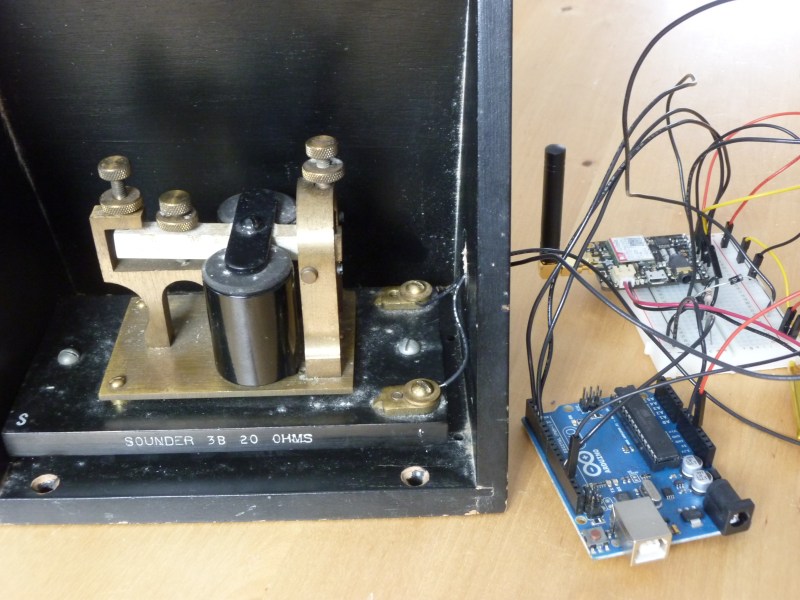If you find yourself glued to social media and also wish to know Morse code… we can think of no better invention to help hone your skills than the Twitter Telegraph. This vintage to pop culture mashup by [Devon Elliott] is a recent project that uses a sounder from the 19th century to communicate incoming tweets with dots and dashes.
Back in the day when everyone was connected by wire, the sounder was a device on the receiving end of the telegraph which translated the incoming signal to an audible clicking. Two tall coils sat with a metal tab teetering between them. When electricity surged into one of the coils it would magnetize, pulling the tab downward in a pattern which mimicked the incoming current sent from the other end. [Devon] decided to liberate the sounder from its string-and-two-can origins and use a more modern source of input. By adding a FONA board which comes equipped with a SIM card, the device was capable of connecting and receiving data from the Internet. An Arduino is responsible for taking the data received and translating it into Morse code using the Mark Fickett’s Arduinomorse library, and then sending it out through an I/O pin to the sounder itself to be tapped.
The finished project is connected to a cellular network which it uses to receive SMS messages and tweets. By mentioning the handle @ldntelegraphco you can send the Twitter Telegraph your own message which will be tapped in code for everyone in the vicinity to hear… which is worth giving a try for those of you curious types. Lastly, if you have an interest in taking a look at the code for your own use, it is available on [Devon’s] github.
















Needs a little more “Steam Punk” in its look.
Please, no.
+1 =F
If Twitter is the platform for Tweeting, then the platform for Pecking would be…. oh my
Perfect.
Exactly.
Having been exposed to old printed materiel when I was young, I knew the difference between Morse and the International Code. Most of what I read that was contemporary did not know the difference, that was 1970. Now I am really confused when I read this.
It’s the difference between a Click and it’s space before and after, and the length of a beep or a beeeeeep. The codes are different. The click stuff is not part of ham radio. A CPO beeps, a sounder clicks. But ask any ham if they know Morse they will assume International Code.
Oh, and Vail should get the credit.
Twitter twits-Twitter flits- Flitter twits- Flitter flits. So many small birds!
I really doubt that there are that many around that can copy code using a sounder like this The two retired RR telegraphers I knew are long dead. One of the told me they used Prince Albert tobbaco tins to make a better resonator.
Not as cool as this but a little easier to copy is my tweet to morse code translator demo http://youtu.be/19zahT0Cxss
The Prince Albert tin in the resonator is perhaps the original telecommunications hack. I’ve seen and heard it demonstrated by a Morse historian, and it really does help amplify the sounder above the amibiant noise.
Just for you Justice_99!
.-..-. …. . .-.. .-.. — –..– / -.. — / -.– — ..- / …. .- …- . / .–. .-. .. -. -.-. . / .- .-.. -… . .-. – / .. -. / .- / -.-. .- -. ..–.. .-..-. / .-..-. -.– . … / .– . / -.. — .-.-.- .-..-. / .-..-. .– . .-.. .-.. / .– …. -.– / -.. — -. .—-. – / -.– — ..- / .-.. . – / …. .. — / — ..- – ..–.. .-..-.
LOL. Browser or WordPress seems to have mangled it. But something about Prince Albert in a can?
Can’t really peck a long “dah”, Tap code is better suited for that!
A sounder has a starting click and a finishing clack corresponding to the duration of the key press. You can differentiate between dits and dahs by noting the length of time between click and clack.
Yes, but birds don’t really have a realease-peck sound (re twitter reference)
Interesting idea, as the pace may give one one time to rethink the wording, intent or quality of one’s post.
Perhaps HaD should consider Morse only comments?
It would be interesting to see trolling in Morse code. I’m sure a few here would be determined enough to learn it just to bitch about the grammar and spelling of the staff here.
Those who’d like to step back to an era when telegraphy was the latest new technology might want to read an 1880 novel called Wired Love. It anticipated a lot of the messaging we do today in relationships:
http://www.loyalbooks.com/book/Wired-Love-by-Ella-Cheever-Thayer
We only think we live in a brave new world.
Thanks for the link, can’t wait to read it!